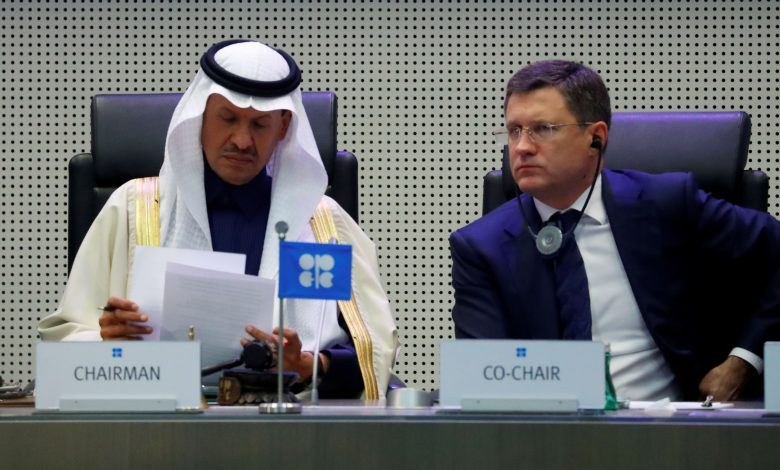These are the three big things to focus on from OPEC and the G-20 meetings over the next 48 hours

[ad_1]
Saudi Arabia’s Minister of Energy Prince Abdulaziz bin Salman Al-Saud and Russian Energy Minister Alexander Novak at the start of an OPEC and NON-OPEC meeting in Vienna, Austria, December 6, 2019.
Leonhard Foeger | Reuters
There are three big things to focus on from OPEC and the G-20 meetings over the next 48 hours: 1) total global output cut, 2) benchmark production levels for those cuts, and 3) the length of time of any formal deal.
The Cut Math
The world is expected to cut an unprecedented 12 million to 15 million barrels of oil per day from global production. Assuming talks don’t break down, here’s a very simplistic possible breakdown of how the cuts play out garnered from a variety of research:
- OPEC = 5 million to 6 million barrels per day
- Russia = 1.5 million barrels per day
- US = 1.5 barrels per day, within a few months
- Brazil, Canada, Mexico = 1.2 million to 1.5 million barrels per day
- Norway = 250,000 barrels per day
- Others = 1 million barrels per day
So by late Friday a variety of agreements could be made to remove nearly 12 million barrels of oil from the daily global market.
But like everything with global energy politics, it’s not that simple.
Benchmarks and quotas
One major sticking point of any OPEC+ Russia deal is from what level of production do any Saudi cuts originate.
Saudi production has risen over the past two months as the market share and price war kicked off. The Saudis are willing to cut more than any single producer, but Russia and Iran have made it fairly clear that whatever cuts come from the Kingdom must come from pre-output surge levels, not current production. In other words, if the Saudis cut, say, 3 million barrels per day, that should come off of the 10 million output figure, not the newer 12.5 million level, because then was it really a big cut at all? This benchmark debate will likely be key inside the virtual room.
On the U.S. side, keep in mind that we have neither a national American producer nor an OPEC, so there is no way for us to assure OPEC or the G-20 that any cuts can be guaranteed. It’s every company for itself in the Permian Basin right now.
But there are two big things OPEC leaders will be watching here: first, the level of capital spending cuts by Exxon, Chevron, Occidental and other major players has been sizeable, so the group knows U.S. output will fall from natural attrition and lack of new well drilling.
Also, the Texas Railroad Commission, the obscure three-person organization that regulates that state’s oil production, could vote April 21st to impose production quotas or caps. It’s a hot topic for another day, but if OPEC believes the commission will vote for quotas, it could take another million or so barrels from the global market.
For how long
Maybe even more vital than the output cut size are the length of any deals made. The world is oversupplied by 25 million to 30 million barrels per day of oil. So whatever happens at OPEC and the G-20 won’t be enough to balance the market. The goal is only to minimize the damage until the world can get back on its economic feet.
An extra 30 million barrels of oil floating around the world (literally, now, on ships) could grow to 2.7 billion barrels over the next three months. That would completely overwhelm global storage and oil could quickly slide to single-digit prices.
Taking 15 million barrels per day from that supply cuts 1.35 billion barrels from those totals over the next 90 days, and makes managing that storage a little easier, with hope that economies everywhere begin to recover sooner than later and demand picks back up.
Hope may be the key word as these tense negotiations kick off today. The longer a deal, the better, or markets may simply decide the path of least resistance for prices is down once again.
Source link





